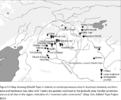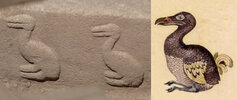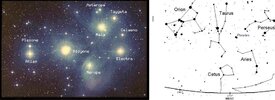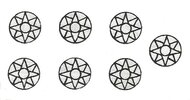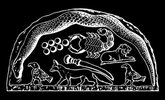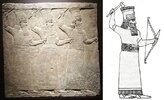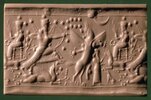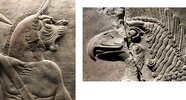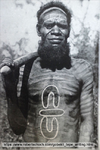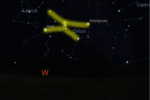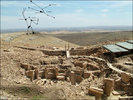3. THE BELT
What appears to be a ‘belt’ flows around the middle of the entire T-pillar. Upon both sides there are devices embossed that we are by now more than familiar with. Belts are once again regarded as distinctively male signifiers by archaeologists.

There are a number of clear images of the Eastern side available (above)...
Seemingly, however, no one appears to be much interested in the opposite Western side and I have yet to find a single picture originating from the site in the public domain. Thankfully, highly accurate reproductions of both central pillars were erected at the Archaeological Museum of Sanliurfa City and the below (apologies for the quality) comes from the best picture of that I can find.

So the Western belt goes:
And the eastern belt:
Endeavoring to accurately decipher this is a fools game and in some ways possibly anyone’s guess. However, I will tentatively suggest on my part that on the Eastern side the first C and C coupled with the first H are being designated as a distinct unit - and that the two crescents constitute or equals the H (twins) and this may be a way of notating the revolving, circular nature of the crescent horns about the girth of the central god. The completed CHC (in reverse) therefore may denote the complete ‘holy’ relationship.
For some as yet unapparent reason it says effectively the same thing on the eastern side but minus the first C, C and H. Why there is a difference between the two sides I have yet to surmise but it could – could – be connected to the fact that the Fox also only appears on the Eastern side. The fact that the ecliptic travels from east to west could possibly be something to bear in mind because this may have been the path taken by distant travelers…
Whatever the case I tentatively state that the code on the belt further supports and amplifies the motifs at the throat of the god.
Have I missed anything here do you think or do you agree this might be on the right track?
From here on in we will start to head out into even deeper water, starting with point 4. on our list.
4. THE LOINCLOTH

I do not know where to begin with deciphering this complex puzzle so I am just going to give some bullet notes as they come out by way of a road map to possible deductions:
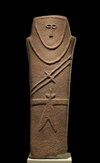
The only element I have listed that I will hold to for now is the apparent importance of the Fox. That I am reasonably confident of, especially as a fully formed Fox appears on the Eastern side of this crucial pillar 18. It is therefore high time we considered this.
2. RELIEF IMAGE OF A FOX
Having mapped the enclosures A-D, archaeologists have concluded from the number of representations present that each has its own dominant animal as follows:
In their wisdom they go on to suggest this denotes how separate hierarchical hunting groups self-identified and likely prioritised their stalking activities. Moving swiftly along…!!!
No, obviously I do not think this was at all about hunting (unless it was humans who were being hunted, and then from the above not from upon the ground!) Furthermore, volume of any particular animal may not actually denote anything intrinsically essential or determinant to the purpose and ‘theology’ of any given enclosure – such an idea remains to be seen in the context of other information if it ever is to be validated.
Thus, despite the predominance of bird images in enclosure D, I suggest it is the highly visible, and beautifully realised relief of a fox depicted on the eastern flank of pillar 18 that for now speaks to us loudest.

Some observations:
But why the fox? After all wolves, lions (and possibly leopards), boars and importantly Auroch bulls are all present within the site and all would appear to be much more fierce and intimidating that the desert fox (if that was an intention?)
Let us also not lose sight of our previous observations concerning the Fox pelt/comet (?) at the groin of the T-pillar.
Here I am going to leap forward some eight thousand years or so and examine a little known Sumerian/Babylonian constellation called The Fox to see if there might be any clues that could provoke an interesting line of further enquiry. Of course this is fraught with some of the same issues I raised in my previous critique of Sweatman, but at least there is some logic in that the two are identical in their symbolic zoology.
THE FOX - in ancient star lore

The Fox on entitlement stones. Babylonian kudurrus of King Melishipak (1185-1171 BC) and King Marduk-zakir-shumi (854-819 BC). Kudurrus were legal inscriptions for land grants by the King and included the symbols of gods who sanctified the transfer of property.
If asked, we would probably all state that foxes represent cunning and craftiness. Well this identity goes way, way back and was exactly how the Sumerians and Babylonians viewed the creature. He was known as the 'thief of the open country' and in astrological lore his star 'is for breaking into houses'. In Sumerian the Fox-star was written ‘Mul Ka-a’ (and in Akkadian was called šēlebu). The Ka-sign depicted the head of a fox, but rather than being used to merely represent the animal itself it was used to signify the perceived nature of the fox - "deceitful, criminal lying and rebellious'. The final A-sign is used as a grammatical element that transforms the quality of being 'deceitful’ represented by the Ka-sign into a noun form - the name of the Fox can therefore be understood as ‘the deceitful one’.
In terms of location, according to Mul-Apin the Fox is 'the star that stands on the Wagon's shaft’ (the Wagon being what we know now as Ursa Major or the Great Bear, part of the great set of northern circumpolar constellations surrounding the still centre of the sky). Greek star-lore provides a more specific location when it identifies the Fox as the faint star that stands above the middle star of the Wagon’s shaft.
The regent of the Fox-star is the unpredictable and fear-inspiring god known as Erra. His name was probably derived from the Akkadian word ‘to dry up’ and he appeared as the god of uncontrolled fire, fever and plague; his principle symbols were the scimitar and a lion-headed staff. At a very early stage he was closely identified with another Akkadian god called Nergal, so much so, that in practise they can be difficult to distinguish. Nergal is generally also described as the god of war, plague and death. Thus, like the ill-omened constellation of the Wolf and Panther, the Fox is commonly used as a name for the malevolent planet Mars. The Ka-sign is also the primary element in another common name for Mars – ‘the False One’.
The deathly nature of the Fox-star is revealed in the Erra Epic, probably composed in the 9th or 8th century BCE, which describes how Erra had taken temporary control of the world and was intent on destroying the city of Babylon. A portent of the forthcoming carnage was revealed in the heavens by the behaviour of his star:
The death star theme is also present in astrology omens, which reveal that even kings cannot escape the fate predicted:
As mentioned earlier, the Fox-star was also known to Greek star-lore. In a remark I believe of monumental significance, the Scholiast on Aratus informs us that one of the stars of the Pleiades left her sisters when the Greeks sacked the city of Troy and retired to a location ‘above the second star of the beam, and that others call this star the Fox’. Proclus makes an equally remarkable statement concerning it: the Fox-star nibbles continuously at the throng of the yoke that holds together heaven and earth.
The symbol of the rope that holds together heaven and earth is found in Mesopotamian literature from the very earliest times. In essence they indicate that the circumpolar region of heaven were attached to a ‘rope’ whose other end was secured to the earth by a ‘Mooring Post’ secured below the horizon. The ‘thong of the yoke’ nibbled by the Fox identifies the rope as the harness-work of the Wagon. When the Fox finally gnaws through the rope, the present World-Age will come to a catastrophic end and the heavens will fall.
Well…. I will be coming onto the complex interconnected series of constellations that made up the ‘Ropes of Heaven’ shortly. Suffice to say for now I think that we are at last heading into deep precession territory here.
Where does this all leave us?
Despite the time gap, we have some extremely tantalising leads. That the Fox was likely way more than just a minor supporting character of the range of symbols on Pillar 18 I hope is becoming clearer.
In particular, its ancient accredited close association with the planet Mars starts to come into sharp relief, especially when we consider in Cometary Encounters Pierre has suggested 10,600 BCE as a Mars/Earth interaction.
Next up I am going to tackle the last of our list of five puzzles, namely the line of 7 birds in relief, moving from right to left (West to East) on the front panel of the base of the pillar. For here we will be picking up on the strange reference to the Pleiades in relation to the Fox-star made by the Scholiast on the work of the poet Aratus. For I have reason to believe that a deep dive into the meaning and implications behind the lore of the Seven Sisters may well lead us into the deepest most profoundly rewarding water of all.
What appears to be a ‘belt’ flows around the middle of the entire T-pillar. Upon both sides there are devices embossed that we are by now more than familiar with. Belts are once again regarded as distinctively male signifiers by archaeologists.

There are a number of clear images of the Eastern side available (above)...
Seemingly, however, no one appears to be much interested in the opposite Western side and I have yet to find a single picture originating from the site in the public domain. Thankfully, highly accurate reproductions of both central pillars were erected at the Archaeological Museum of Sanliurfa City and the below (apologies for the quality) comes from the best picture of that I can find.
So the Western belt goes:
C C H C H C (in reverse)
And the eastern belt:
C H C (in reverse)
Endeavoring to accurately decipher this is a fools game and in some ways possibly anyone’s guess. However, I will tentatively suggest on my part that on the Eastern side the first C and C coupled with the first H are being designated as a distinct unit - and that the two crescents constitute or equals the H (twins) and this may be a way of notating the revolving, circular nature of the crescent horns about the girth of the central god. The completed CHC (in reverse) therefore may denote the complete ‘holy’ relationship.
For some as yet unapparent reason it says effectively the same thing on the eastern side but minus the first C, C and H. Why there is a difference between the two sides I have yet to surmise but it could – could – be connected to the fact that the Fox also only appears on the Eastern side. The fact that the ecliptic travels from east to west could possibly be something to bear in mind because this may have been the path taken by distant travelers…
Whatever the case I tentatively state that the code on the belt further supports and amplifies the motifs at the throat of the god.
Have I missed anything here do you think or do you agree this might be on the right track?
From here on in we will start to head out into even deeper water, starting with point 4. on our list.
4. THE LOINCLOTH

I do not know where to begin with deciphering this complex puzzle so I am just going to give some bullet notes as they come out by way of a road map to possible deductions:
- For once I am with Sweatman in that I see a potential comet identifier. The head and the spread three-pronged tail are highly suggestive of the same. For what it’s worth here is a stella from El-Maakir-Qaryat al-kaafa near Ha’il, Saudi Arabia, and dating from the 4th millennium BCE, which again suggest this motif carries a long held identification with the power of comets.

- But I also see a clear Fox pelt – with the two legs ending in claws between which the long flattened tail of a fox runs down the middle, all pretty obvious to my eye.
- We have a total of five H configurations, three on the left as we look at it head on, and two on the right. The left hand three (on the Eastern side) comprise two in the form we have met before but the top H is here turned to the left onto its side. On the right (the Western side) the two others seemingly mirror this sideways configuration.
- What this could means is best left open. My only comment for now being, could this denote the disruption to the original form caused by a giant comet coming into the plane of the ecliptic and traveling destructively from east to west? Could they even be time markers of some form? All total guesswork however. It likely means something with more nuanced origins.
- The head seems to still have the bull’s horns cupping a now three-pronged object that is no longer circular – could this be a further cometary image/object coming downwards into the uplifted bull’s horns…?
- The other thing to consider is the possibility that this whole item - whatever it represents - is actually being worn as a trophy.
- There is also the possibility that the placement at and over the belly/groin region is connected in some way to the ideas we have seen before on the totems etc of something powerful emerging from the procreative region of the god.
The only element I have listed that I will hold to for now is the apparent importance of the Fox. That I am reasonably confident of, especially as a fully formed Fox appears on the Eastern side of this crucial pillar 18. It is therefore high time we considered this.
2. RELIEF IMAGE OF A FOX
Having mapped the enclosures A-D, archaeologists have concluded from the number of representations present that each has its own dominant animal as follows:
A: SNAKES
B: FOXES
C: BOARS
D: BIRDS
In their wisdom they go on to suggest this denotes how separate hierarchical hunting groups self-identified and likely prioritised their stalking activities. Moving swiftly along…!!!
No, obviously I do not think this was at all about hunting (unless it was humans who were being hunted, and then from the above not from upon the ground!) Furthermore, volume of any particular animal may not actually denote anything intrinsically essential or determinant to the purpose and ‘theology’ of any given enclosure – such an idea remains to be seen in the context of other information if it ever is to be validated.
Thus, despite the predominance of bird images in enclosure D, I suggest it is the highly visible, and beautifully realised relief of a fox depicted on the eastern flank of pillar 18 that for now speaks to us loudest.

Some observations:
- To remind you this relief is not repeated on the other side
- The fox is aligned to the north to south axis of the whole pillar.
- It might be said to be resting within (or perhaps emerging from?) the crook of the T-pillar god’s elbow.
- Its teeth are bared in a typical pose of attack. This sense of alertness is amplified by the pricked up ears and its tail being elongated down the line of the spine.
- Whether this is or isn’t meaningful, we should also note that its jaws align with the midpoint of the vertical channel running from the throat to the groin on the front of the T-pillar figure.
- By its erect genitalia, it is clearly male.
- Its legs might be suggestive that the animal is running at a pace (though it should be said this form is standard throughout the site).
But why the fox? After all wolves, lions (and possibly leopards), boars and importantly Auroch bulls are all present within the site and all would appear to be much more fierce and intimidating that the desert fox (if that was an intention?)
Let us also not lose sight of our previous observations concerning the Fox pelt/comet (?) at the groin of the T-pillar.
Here I am going to leap forward some eight thousand years or so and examine a little known Sumerian/Babylonian constellation called The Fox to see if there might be any clues that could provoke an interesting line of further enquiry. Of course this is fraught with some of the same issues I raised in my previous critique of Sweatman, but at least there is some logic in that the two are identical in their symbolic zoology.
THE FOX - in ancient star lore

The Fox on entitlement stones. Babylonian kudurrus of King Melishipak (1185-1171 BC) and King Marduk-zakir-shumi (854-819 BC). Kudurrus were legal inscriptions for land grants by the King and included the symbols of gods who sanctified the transfer of property.
If asked, we would probably all state that foxes represent cunning and craftiness. Well this identity goes way, way back and was exactly how the Sumerians and Babylonians viewed the creature. He was known as the 'thief of the open country' and in astrological lore his star 'is for breaking into houses'. In Sumerian the Fox-star was written ‘Mul Ka-a’ (and in Akkadian was called šēlebu). The Ka-sign depicted the head of a fox, but rather than being used to merely represent the animal itself it was used to signify the perceived nature of the fox - "deceitful, criminal lying and rebellious'. The final A-sign is used as a grammatical element that transforms the quality of being 'deceitful’ represented by the Ka-sign into a noun form - the name of the Fox can therefore be understood as ‘the deceitful one’.
In terms of location, according to Mul-Apin the Fox is 'the star that stands on the Wagon's shaft’ (the Wagon being what we know now as Ursa Major or the Great Bear, part of the great set of northern circumpolar constellations surrounding the still centre of the sky). Greek star-lore provides a more specific location when it identifies the Fox as the faint star that stands above the middle star of the Wagon’s shaft.
The regent of the Fox-star is the unpredictable and fear-inspiring god known as Erra. His name was probably derived from the Akkadian word ‘to dry up’ and he appeared as the god of uncontrolled fire, fever and plague; his principle symbols were the scimitar and a lion-headed staff. At a very early stage he was closely identified with another Akkadian god called Nergal, so much so, that in practise they can be difficult to distinguish. Nergal is generally also described as the god of war, plague and death. Thus, like the ill-omened constellation of the Wolf and Panther, the Fox is commonly used as a name for the malevolent planet Mars. The Ka-sign is also the primary element in another common name for Mars – ‘the False One’.
The deathly nature of the Fox-star is revealed in the Erra Epic, probably composed in the 9th or 8th century BCE, which describes how Erra had taken temporary control of the world and was intent on destroying the city of Babylon. A portent of the forthcoming carnage was revealed in the heavens by the behaviour of his star:
‘The star of Erra is twinkling and carries rays… His mantle of radiance will be activated and all the people will perish.’
The death star theme is also present in astrology omens, which reveal that even kings cannot escape the fate predicted:
‘If the great god, the Fox-star… in this year in all lands the king will die.’
As mentioned earlier, the Fox-star was also known to Greek star-lore. In a remark I believe of monumental significance, the Scholiast on Aratus informs us that one of the stars of the Pleiades left her sisters when the Greeks sacked the city of Troy and retired to a location ‘above the second star of the beam, and that others call this star the Fox’. Proclus makes an equally remarkable statement concerning it: the Fox-star nibbles continuously at the throng of the yoke that holds together heaven and earth.
The symbol of the rope that holds together heaven and earth is found in Mesopotamian literature from the very earliest times. In essence they indicate that the circumpolar region of heaven were attached to a ‘rope’ whose other end was secured to the earth by a ‘Mooring Post’ secured below the horizon. The ‘thong of the yoke’ nibbled by the Fox identifies the rope as the harness-work of the Wagon. When the Fox finally gnaws through the rope, the present World-Age will come to a catastrophic end and the heavens will fall.
Well…. I will be coming onto the complex interconnected series of constellations that made up the ‘Ropes of Heaven’ shortly. Suffice to say for now I think that we are at last heading into deep precession territory here.
Where does this all leave us?
Despite the time gap, we have some extremely tantalising leads. That the Fox was likely way more than just a minor supporting character of the range of symbols on Pillar 18 I hope is becoming clearer.
In particular, its ancient accredited close association with the planet Mars starts to come into sharp relief, especially when we consider in Cometary Encounters Pierre has suggested 10,600 BCE as a Mars/Earth interaction.
Next up I am going to tackle the last of our list of five puzzles, namely the line of 7 birds in relief, moving from right to left (West to East) on the front panel of the base of the pillar. For here we will be picking up on the strange reference to the Pleiades in relation to the Fox-star made by the Scholiast on the work of the poet Aratus. For I have reason to believe that a deep dive into the meaning and implications behind the lore of the Seven Sisters may well lead us into the deepest most profoundly rewarding water of all.
Last edited:



